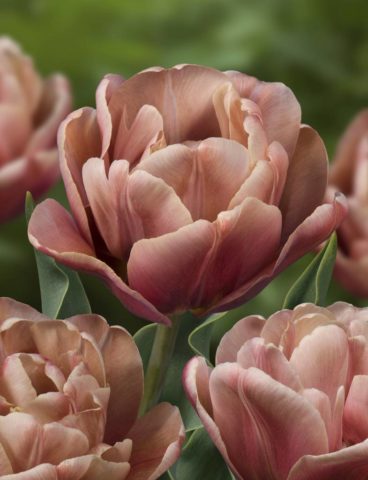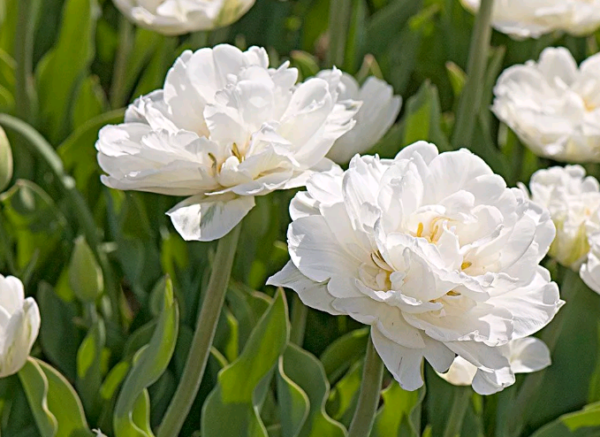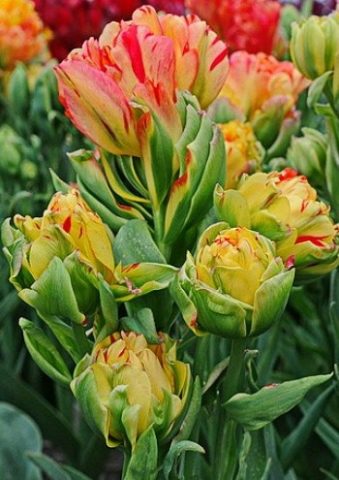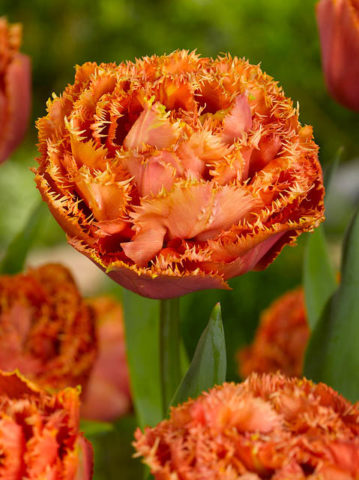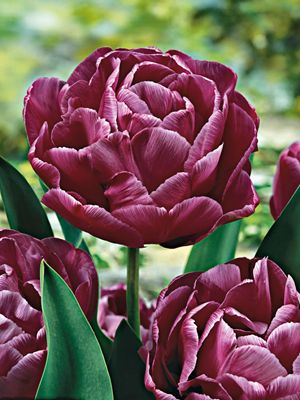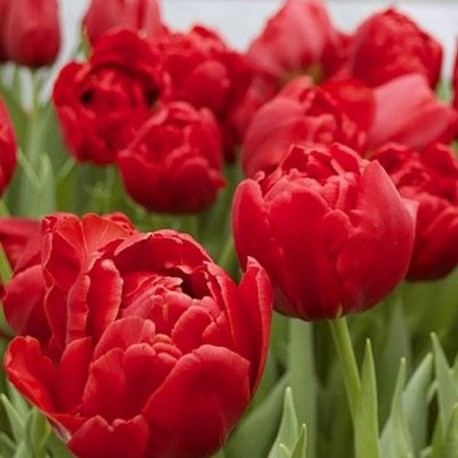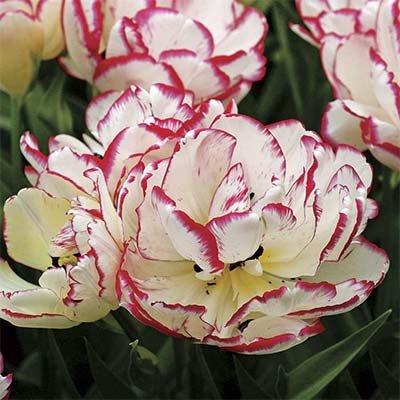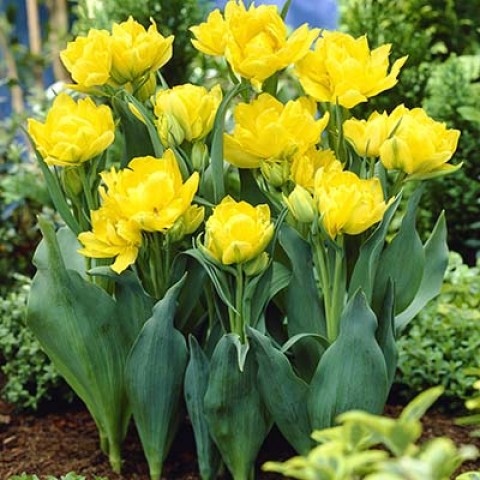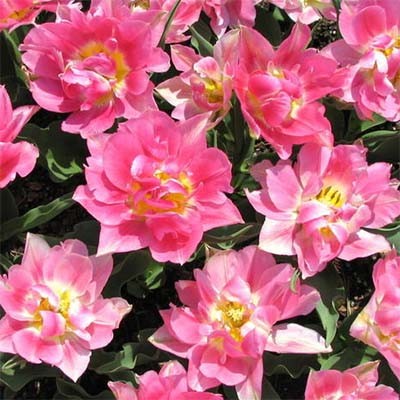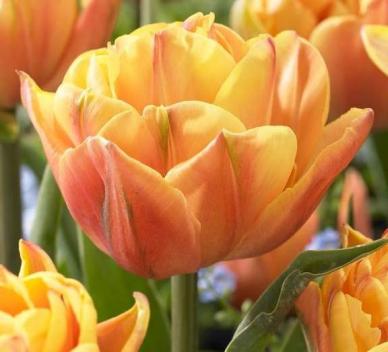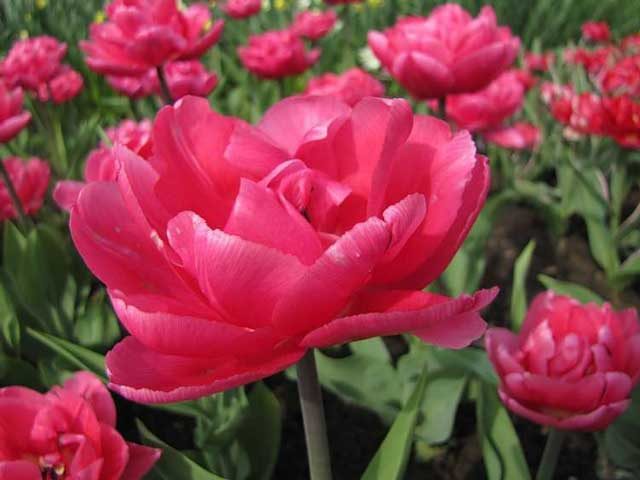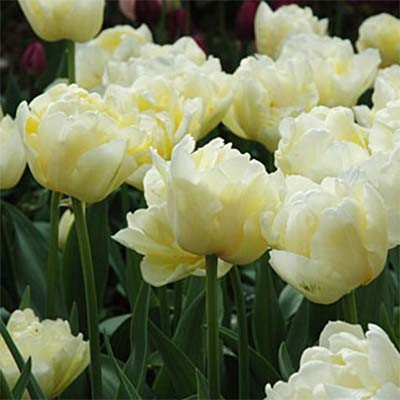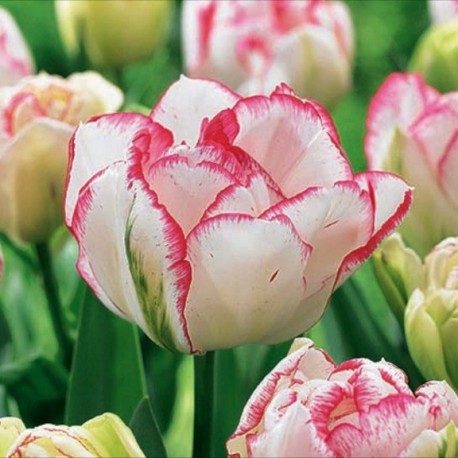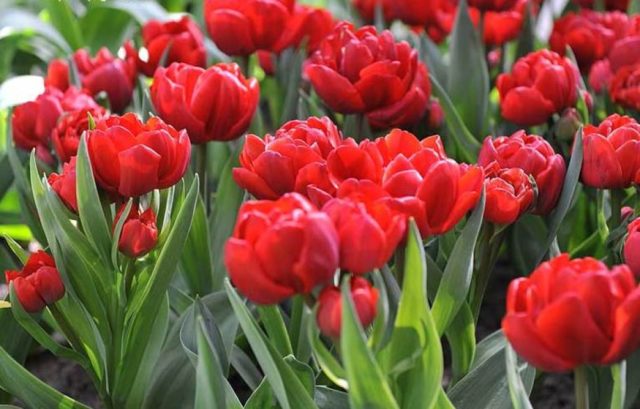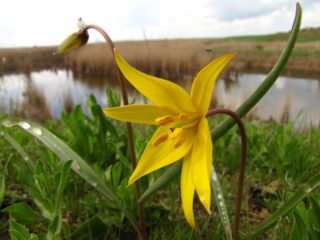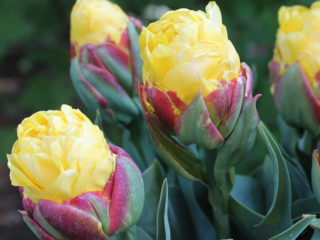Content
Among those who grow tulips, there are many lovers of double flowers, which vaguely resemble peonies and can be of various colors. Terry tulips include many varieties, from which the gardener can choose the one that will suit his wishes.
Description of terry tulips
Tulips with double flowers were first produced in Holland at the beginning of the 17th century. And this happened by accident, but later the breeders began to select the best specimens and gradually developed the first terry variety from them.
Unlike ordinary simple tulips, the flowers of which are formed by 2 rows of petals, double tulips have one more flower in place of the inner whorl, and 3 additional petals in place of the stamens in the 3rd whorl. All this creates lush flowers of double tulips.

The double tulip flower looks fuller and richer
Varieties of terry tulips
Modern terry varieties are divided into early and late. Both plants can bloom for up to 2 weeks. The early varieties have small flowers, but they bloom quickly, the tulips themselves are not tall, the later varieties are taller and have larger flowers (they can be up to 10 cm in diameter).They are most often planted for the purpose of forcing and cutting. The color of the petals of both is varied; they can be white, yellow, pink, red, orange.
Varieties of late double tulips
Many varieties of tulips belonging to the late group have been bred. Among them you can choose the following:
- La Belle Epoque. The petals are light pink-powdery in color, the bush grows up to 55 cm. The flowers are very large and do not fade for a long time.
- Mount Tacoma. The flowers are bright white and bloom for up to 3 weeks.
- Blue Diamond. The flowers consist of double petals of a beautiful purple-violet color.
- Miranda. Each flower consists of approximately 50 red petals, which gives them a pronounced decorative effect.
- Lilac perfection. The flower has lilac petals, a yellow center, and blooms for 2-3 weeks.
- Charming Beauty. The petals are salmon-colored with pink strokes, the core is yellow.
- Fruit Cocktail. The petals are narrow, yellow with red stripes.
- Princess Angelique. Petals are light pink with white stripes.
- Sensual Touch. The flowers are large, red-orange, with a fringed edge.
- Royal Acres. The petals are mostly pink-purple, the flowers are lush. In addition to these, breeders have developed many more late varieties, with flowers of other shades.
Varieties of early double tulips
Some of the best double tulips belonging to early varieties:
- Abba. Large flowers with scarlet petals, the outer layer with green stripes.
- Belicia. The flowers are cream-colored, with a border along the edge of the petals. One plant can produce up to 5 flower stalks.
- Monte Carlo. The flowers are large, densely double, juicy yellow in color. It can be grown not only in the garden, but also in pots.
- Peach Blossom. The flowers are very large, the petals are pointed and pink in color.
- Monte Orange. The petals are bright orange with greenish veins.
- Freeman. The petals are yellow-orange, collected in a dense cup.
- Queen of Marvel. The variety has pink-violet petals; this variety is one of the few early ones that is suitable for cutting.
- Verona. Lemon colored petals. Tulips can be grown indoors in pots.
- Cartouche. The petals are white, with crimson stripes. Plants are suitable for cutting.
- Double Toronto. This is a hybrid obtained from a combination of a variety with double flowers and a Greig variety. The plant produces many flower stalks with colorful orange flowers.
As with the late ones, other beautiful varieties can be found in the group of early tulips.
Planting and caring for terry tulips
Although tulips are cold-resistant plants that do not tolerate dampness and cold wind, you need to choose a place for them in the garden that is sunny, open, but protected from the wind. Next to them you can plant crocuses, hyacinths, primroses, daffodils, or decorative perennials, which with their greenery will hide the tulip leaves when they turn yellow and dry out.
As for the soil, tulips do not like clay and acidic soil. If the site has heavy or acidic soils, they need to be improved by adding coarse sand, peat and calcareous materials (chalk, lime, dolomite flour).
Bulbs need to be planted at a soil temperature of 10 °C; at such temperatures they take root well. The best time for planting large double tulips is the 2nd half of September or all of October. Early varieties should be planted 2 weeks earlier than later ones. If for some reason it was not possible to plant spruce in the fall, this can be done in the spring, as soon as the snow melts.But we must take into account that not all bulbs planted in the spring will be able to bloom this year.
Among all the available bulbs, you need to choose the best ones - large, not wilted, completely healthy. If any of them have spots or signs of damage by pests, such specimens are unsuitable for planting.
First you need to prepare the bulbs: soak them for 0.5 hours in a fungicide solution to kill bacteria and fungi on their surface. The beds for tulips also need to be prepared: dug up, fertilized with humus and ash, mixed and leveled. Do not use fresh manure either when preparing the soil or for subsequent fertilizing. It contains a lot of nitrogen compounds that can burn the roots.
When planting, you need to add a handful of sand to each hole, place the onion on it, sprinkle it with soil, and compact it a little. The distance between plants is 25-30 cm.

Bulbs should be planted in warm weather
Caring for terry tulips consists of watering, loosening the soil and fertilizing. Watering must be done carefully; the soil should not be damp; in waterlogged soil, the bulbs may rot. But plants cannot do without watering at all, especially when forcing buds and during flowering, since their roots are small and they are not able to get water from the deep layers of the earth. Water at the root.
Terry tulips need fertilizing 3 times a season:
- In spring, when young leaves appear. The fertilizing mixture should consist of nitrogen, phosphorus and potassium fertilizers in a ratio of 2:2:1.Dilute 50 g of this mixture in a bucket of water and pour 1 square meter of tulips. m.
- When the plants form buds. This time, the proportion of nitrogen in the feeding mixture should be reduced, and phosphorus and potassium should be increased (1: 2: 2).
- After the plants have flowered, they need to be fed again - with a phosphorus-potassium mixture, without nitrogen. Fertilizer consumption for 2 and 3 feedings is 30-35 g per 10 l, distribute this volume per 1 square meter. m.
Fertilizers should not contain chlorine. It is convenient to use complex mixtures for bulbous plants, in which all elements are selected in a balanced manner and in the correct ratio. If you need to get more daughter bulbs, boron and zinc should be added to the watering solution.
After the double flowers have faded, they must be cut off so that the plant does not waste energy on forming seeds. If the flower is cut for a bouquet, you must leave a few leaves on the plant so that it can form a bulb of normal size. Before the onset of cold weather, tulips need to be covered with mulch; under it they will not freeze. Hay, straw, and fallen leaves will do. The layer of insulating material should be at least 5 cm. Next year, as soon as it gets warmer, the mulch should be removed.
Propagation of double tulips
Old bulbs die off after flowering, but daughter bulbs develop near them. One plant can produce different numbers; they can be large or small.
For propagation, you need to choose only the largest ones; small ones produce tulips that do not bloom well. For this reason, only large specimens are also suitable for forcing terry tulips. Small children must first be raised separately (in cups or pots) and then planted in a flower bed.Store the bulbs in damp sand before planting; place the boxes with them in a cool and dry place.
Place the bulbs in the box so that they do not touch each other. If terry tulips belong to several varieties, they need to be labeled so as not to be confused later.
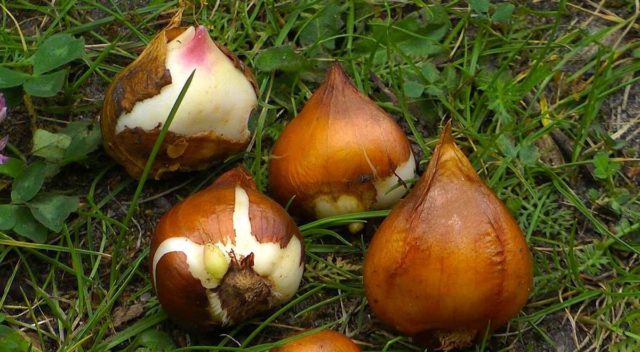
Tulip bulbs used for propagation must be large
Diseases and pests
The most dangerous disease of tulips is the variegation virus. It is not difficult to notice the lesion - strokes, stripes and spots appear on the petals of monochromatic varieties and leaves that are uncharacteristic for them. The virus cannot be treated; diseased plants and bulbs must be destroyed. Tulips should not be placed in the place where they were located for several years. For prevention, you need to disinfect garden tools more often so as not to spread the disease among healthy plants. Preventive spraying with fungicide solutions against fungal diseases will not hurt either.
Photos of terry tulips
You can see what the flowers of some early and late varieties look like in the photo.
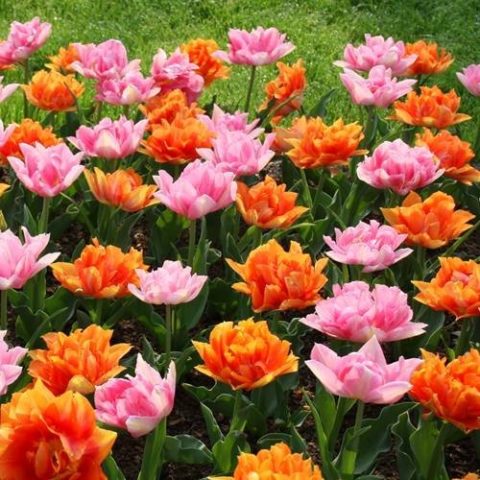
Flowers of the Peach Blossom variety look quite bright and attractive
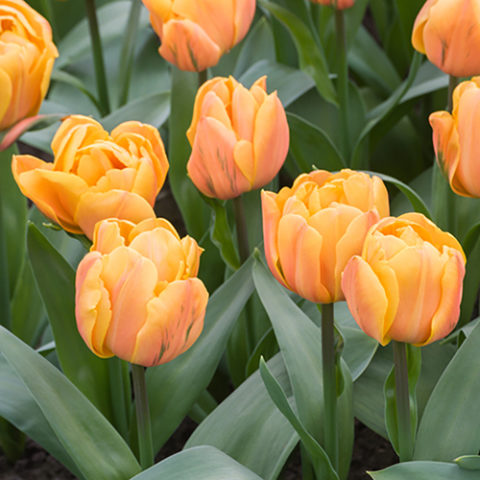
The Freeman variety blooms with delicate buds, the color is deep and noble
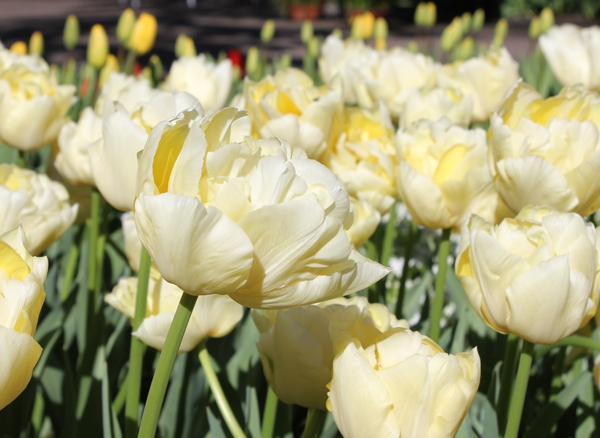
Verona tulips have a rich milky hue
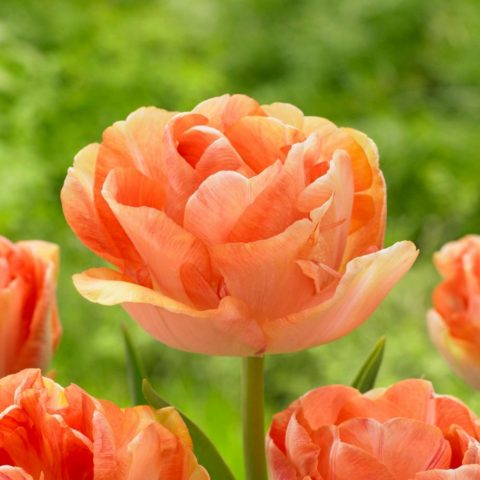
Charming Beauty orange flowers will please the eye even in cloudy weather

Delicate Princess Angelique flowers look beautiful cut in bouquets
Conclusion
Terry tulips are distinguished by lush flowers and a long flowering period, which attracts many gardeners to them. Among them there are early and late varieties with flowers of various colors, this allows you to create the most unusual compositions from them.
